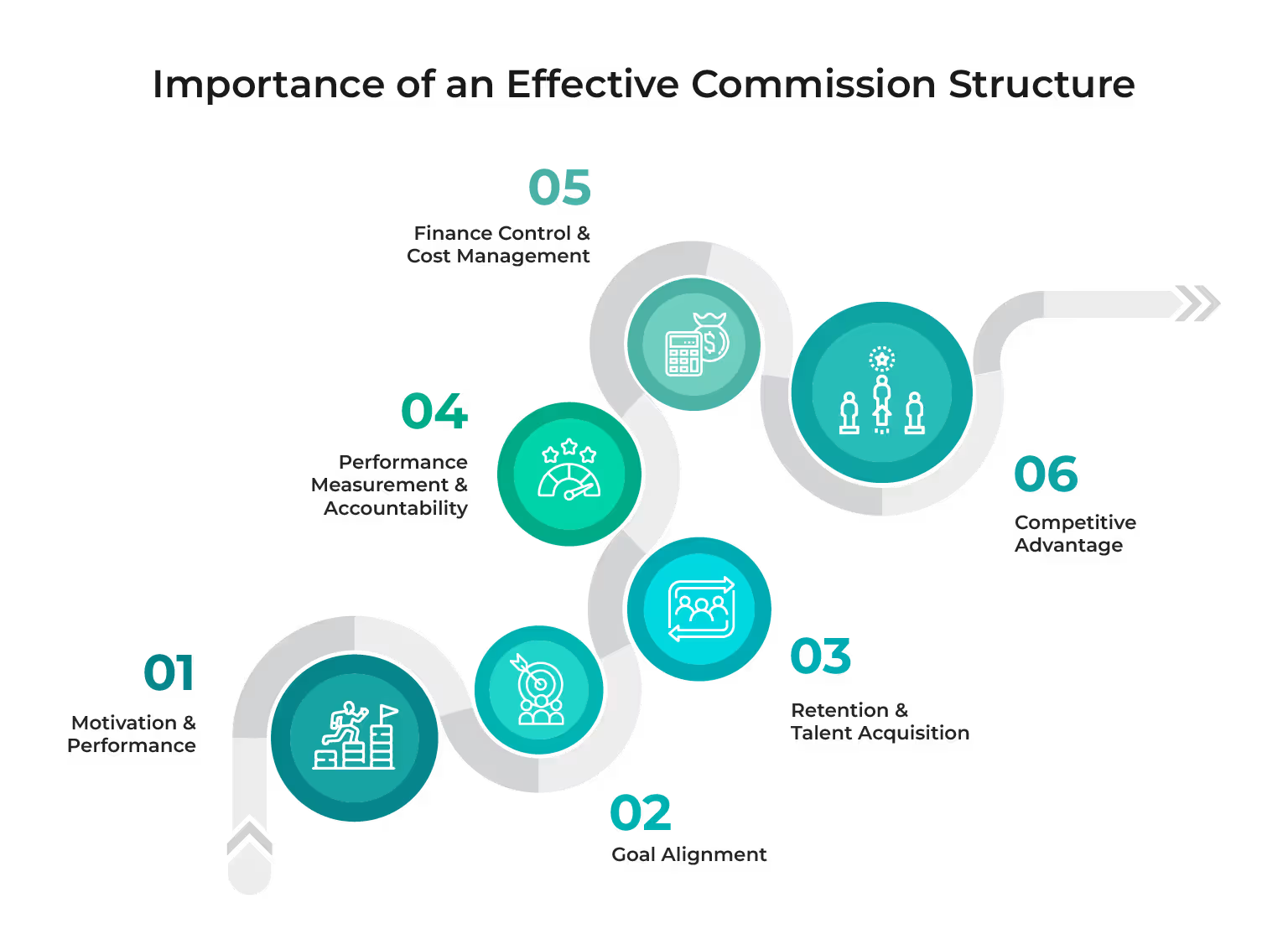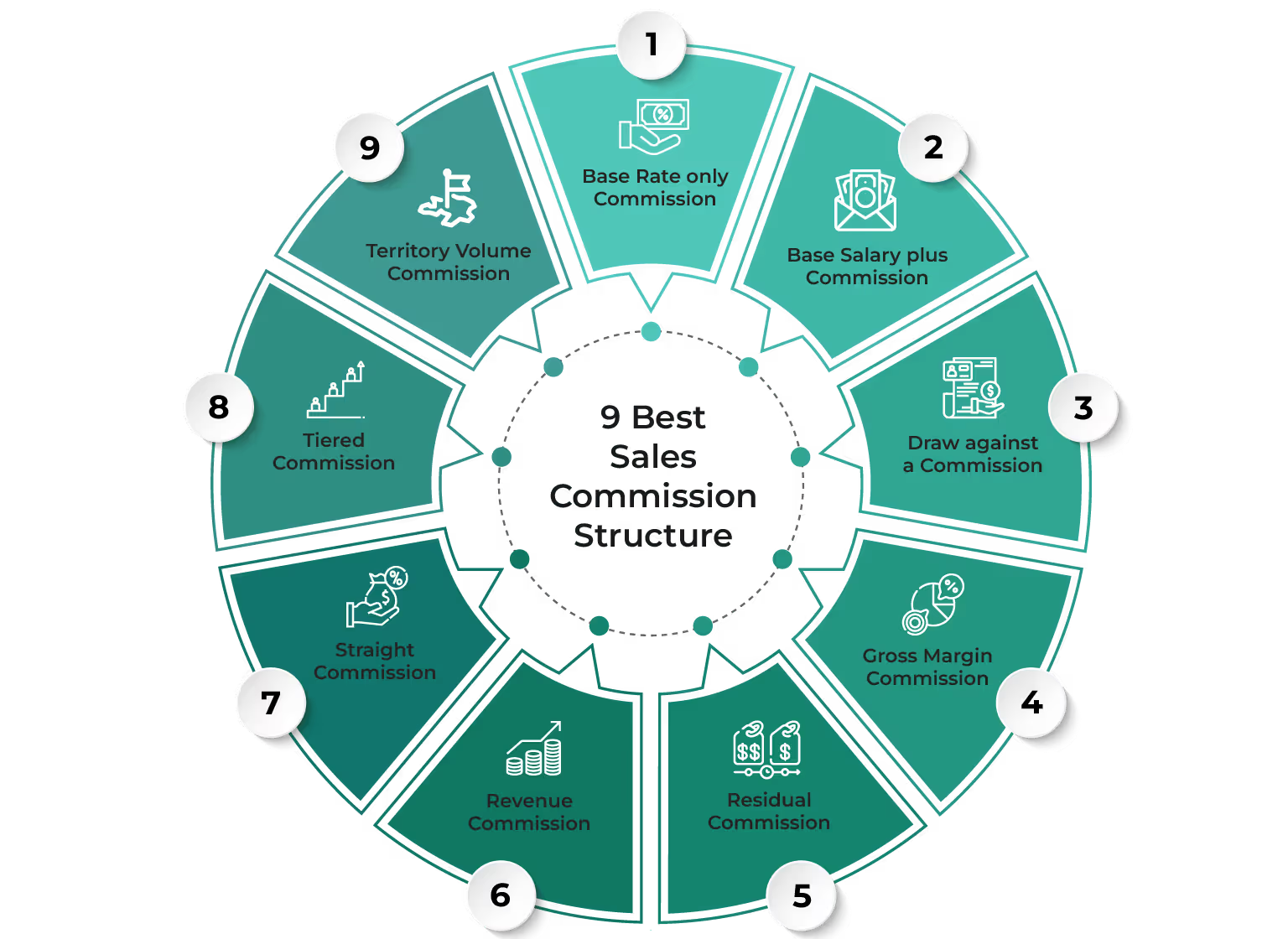
Blog
9 Best Sales Commission Structures for Maximum Performance
November 7, 2022


Key Insights
A sales commission structure refers to the framework or plan that determines how salespeople are compensated based on their sales performance.
It outlines the rules, percentages, and conditions under which commissions are earned and paid out.
The purpose of a sales commission structure is to motivate and reward sales representatives for their efforts in generating sales and driving revenue for the company, while aligning incentives with different stages of the sales pipeline funnel to encourage efficient and effective sales activities.
It serves as an incentive for salespeople to meet and exceed their targets, as their earnings are directly tied to their performance through well-designed sales incentive plans, ensuring a strong alignment between individual goals and overall company objectives.
What is a Sales Commission Structure?
A sales commission structure refers to the framework or plan that determines how salespeople are compensated based on their sales performance.
It outlines the rules, percentages, and conditions under which commissions are earned and paid out.
The purpose of a sales commission structure, closely tied to Commission Expense Accounting, is to motivate and reward sales representatives for their efforts in generating sales and driving revenue for the company while accurately accounting for the associated expenses.
It serves as an incentive for salespeople to meet and exceed their targets, as their on target earnings are directly tied to their performance, motivating them to strive for excellence in their roles.
Importance of an Effective SaaS Sales Commission Structure?
Here are some key reasons why an effective SaaS Sales commission structure is important:

- Motivation and Performance: A well-designed commission structure provides a strong incentive for salespeople or individuals responsible for achieving targets.
- Goal Alignment: An effective commission structure helps align the goals of individual employees with the broader objectives of the organization, including specific sales objectives examples.
- Retention and Talent Acquisition: A well-designed commission structure can attract and retain top talent in a competitive job market.
- Performance Measurement and Accountability: An effective commission structure provides a clear framework for measuring and evaluating individual and team performance.
- Financial Control and Cost Management: While commission structures can be a significant expense for organizations, an effective structure helps manage costs and ensure a positive return on investment.
- Competitive Advantage: An organization with an effective commission structure gains a competitive edge in the market.
How to create a commission structure that works for you? Read on to find out!

9 Best Sales Commission Structures:
Let’s look at the 9 types of commission structures that organizations today swear by-

Base rate only commission
Example: The company’s salespeople each earn $1,000 a week no matter how many sales they make.
In this case, the commission is fixed and no further calculations are necessary.
Base salary plus commission
Example: A salesperson earns $500 a month in salary with 10% commission, or $500 for $5,000 worth in sales. If he sells $20,000 of product in one month, he earns $2,500: $500 in salary and $2,000 in commission.
Calculation for base rate only commission: Commission Percentage * Amount Sold = Commission Total.
In this case, the base salary is usually too low to support someone’s household entirely but does provide a stable guaranteed income when sales are low.
Draw against a commission
Example: A salesperson is expected to earn $4,000 a month in commission and receives $2,000 a month in draw (salary). If they met their $4,000 goal, they earn $2,000 more, the amount over the draw, contributing to their on-target earnings. If they earn only $1,000, they owe the company $1,000, the amount under the draw.
Calculation for draw commission: Commission Total - Draw = Commission Owed.
Gross margin commission
Example: A salesperson is selling a $120,000 car that costs $70,000 to make. The gross margin is $50,000. The salesperson earns 5% on the margin or $2,500 in compensation. Example: A salesperson is selling a $120,000 car that costs $70,000 to make. The gross margin is $50,000. The salesperson earns 5% on the margin or $2,500 in compensation. Calculation for gross margin commission: Total Sale Price - Cost = Gross Margin. Gross Margin * Commission Percentage = Total Commission. In this case, salespersons are not likely to give out more discounts as the amount at which a product is sold influences their earning. A tool like a gross sales calculator can streamline these calculations and offer precise results.
In this case, salespersons are not likely to give out more discounts as the amount at which a product is sold influences their earning.
Residual commission
Example: A salesperson lands a large account. As long as that company pays its premiums of $4,000 a month, the salesperson receives a 5% commission or $200 every month.
Calculation for residual commission: Payment * Commission Percentage = Total Commission.
The benefit is that salespeople are motivated to retain customers this way.
Revenue commission
Example: A car salesperson sells a $20,000 vehicle and earns 4% of the sales. They receive $800 in revenue commission for that sale.
Calculation for revenue commission: Sale Price * Commission Percentage = Total Commission.
Straight commission
Example: A salesperson that sells vacation home rentals earns $100 for every booking. The more time he puts in, the greater the chance of making a sale.
Calculation for a straight commission: Sales x Commission Rate = Income.
Tiered commission
Example: A salesperson's base commission is 5% up to a total of $100,000 in sales. That commission increases to 7% for total sales between $100,001 and $200,000. If they go beyond that and perform over $200,001, they earn 10% in commission. To help you calculate these commissions efficiently, consider using a sales commission calculator.
With this structure, a salesperson is motivated to exceed sales goals.
Territory volume commission
Example: Two salespeople are expected to sell $50,000 in product each month in a particular region. One sells $30,000 while the co-worker sells $20,000. Since the total goal has been met, they split the 10% commission, earning $2,500 each.
Determining the Best Commission Structures for Your Team: (This Needs to be H3)
There are some ways that can help you decide which commission structure is ideal for your organization, such as focusing on making your sales process effective, designing your commission structure around company goals, benchmarking with industry standards, and considering the inclusion of a non-recoverable draw to support sales reps during slower periods.
However, it is not easy to religiously stick to one structure, and more often than not, companies choose to opt for a hybrid option, integrating tools such as a Sales Pipeline tool.
Read this blog “In the Trenches: Sales Compensation Plans that Work in the Real World” to know more!
Whatever your sales commission structure is, Kennect’s ICM solution provides real-time updates on your sales compensation program with a No-code plan builder that helps you customise your IC plans and deliver at 100% accuracy! This empowers compensation analysts to efficiently manage and adapt incentive plans, ensuring alignment with business objectives and accurate payouts.
Book a demo with us today!
ReKennect : Stay ahead of the curve!
Subscribe to our bi-weekly newsletter packed with latest trends and insights on incentives.
Thank you! Your submission has been received!
Oops! Something went wrong while submitting the form.
Your data is in safe hands. Check out our Privacy policy for more info




.avif)









